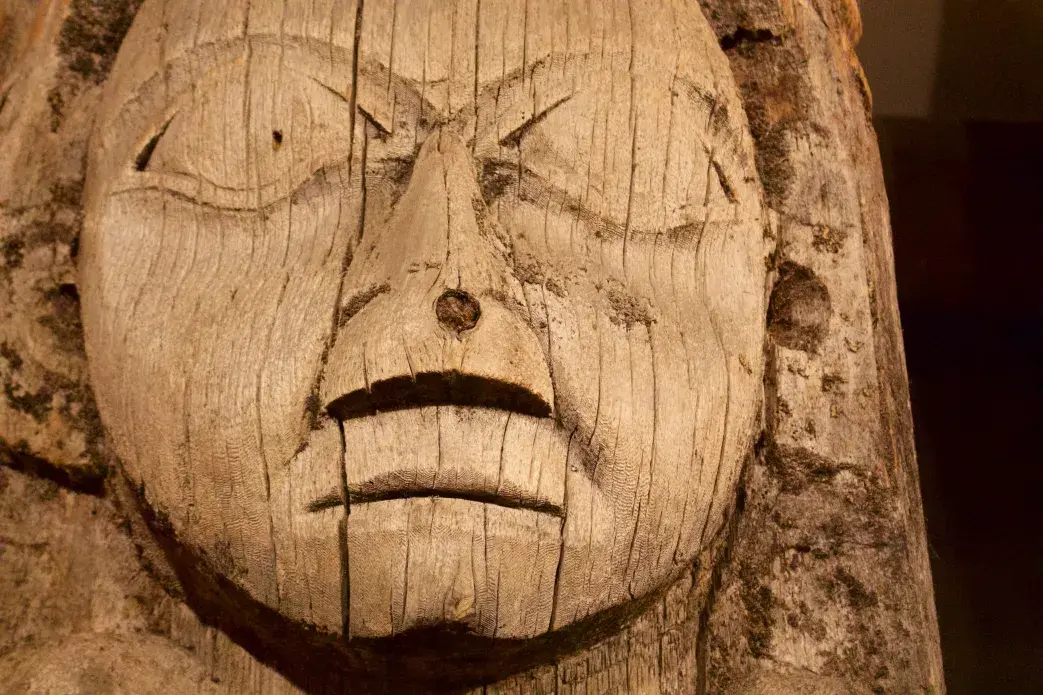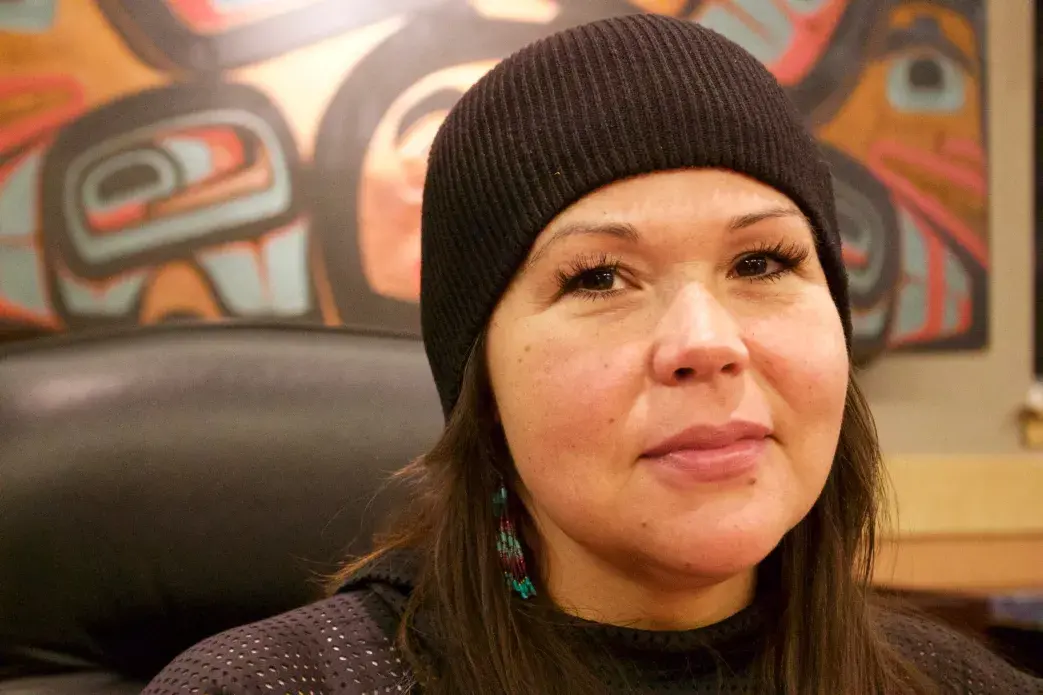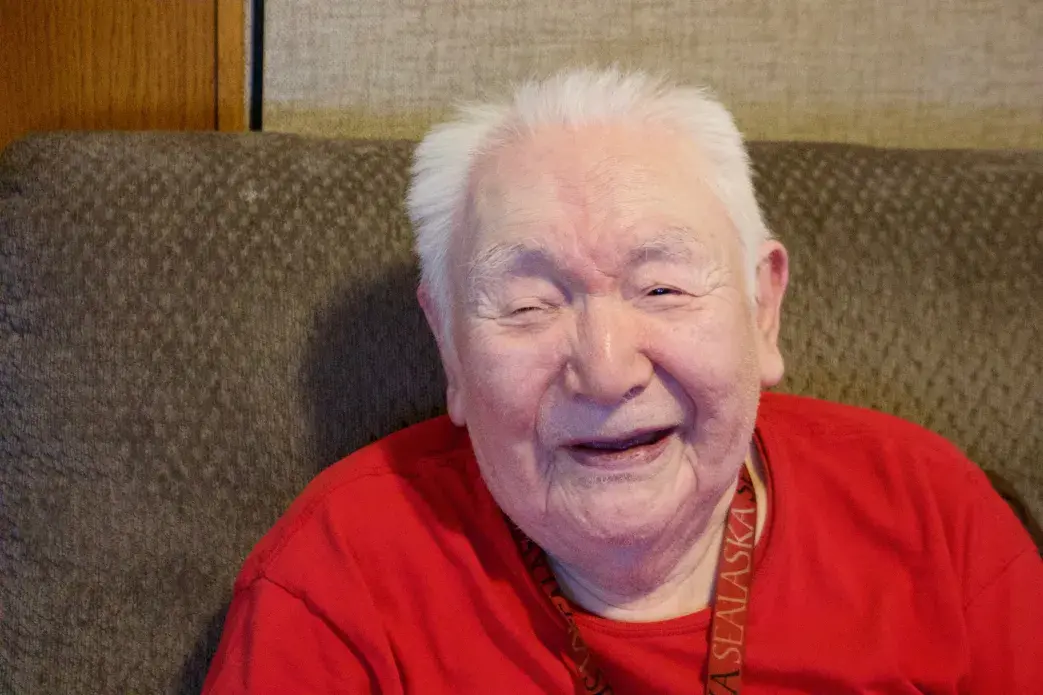Terri Burr hopped in her car, turning on the wipers to sweep the rain from her windshield. She began to drive and talk, barely looking down at the road she takes each morning to meet with her language mentor, John Reese, the 95-year-old, last fluent speaker of the native Alaskan language Shm’algyack in Ketchikan.
Burr stepped out of her car and into a creaking elevator in a fading teal apartment building. She pressed the button for the 11th floor where Reese lives alone in what he and his brother nicknamed the Eagle’s Nest, a nod to their family’s clan. The two have an agreement that before Burr enters the apartment, she calls out to Reese to let him know she has arrived.
“Nda wila waan,” said Burr. (How are you doing?)
“Aam. 'Kam shta malshgn,” said Reese. (Good, come in and tell a joke.)
Burr, a heritage-language facilitator for the Ketchikan Indian Community (KIC), has spent her mornings with Reese for the past eight years. She no longer hyperventilates on her way to these meetings–Reese has always been a strict teacher, and she long struggled with his high expectations–but she remembers her struggle during the first few years.
“The fear made me learn,” she said. “I had to prove myself every single day.”
Burr was determined to learn the native language, not only because of the burden she felt, but because of the panic she noticed in the elders.
“I could see the fierceness in his eyes,” Burr said of Reese. “He didn’t worry about how much time he had until he started working on the language. Then he developed a fear of how much time he had left.”
In September of 2008, when most of the fluent elders were in their 80s and 90s, KIC made it a top priority to save the community’s three languages: Shm’algyack, Xaad Kil, and ‘Lingit. They created a mentor-apprentice program, partnering fluent speakers with language learners. As of today, Ketchikan has one fluent speaker of Shm’algyack, Reese, two speakers of Xaad Kil, and one fluent speaker of ‘Lingit.
“If we don’t keep our language alive, then our culture dies,” said Joe Thomas, a fluent ‘Lingit speaker who lives in Saxman, a town next to Ketchikan. “Our culture, our language, the things that we do, the things that keep us going, die. We will be known statistically as a race that died, a culture that died. We’re already known as a culture that is dying.”
Ketchikan is the southeastern most city in Alaska, with 30 percent of its 5.9 square miles underwater. The town has a population of about 8,000 and is home to three native tribes: the Haida, the Tlingit, and the Tsimshian. The Tlingit are indigenous to the area, and the Haida and Tsimshian both arrived from Canada during the 18th century. Formerly known for a bustling red-light district, a lucrative pulp mill, and a cannery, the town has since become a hotspot for commercial fishing and tourism, with cruise ships harboring on its waters during the warm months.
While language preservation is emphasized in Ketchikan, social problems in the community often take precedent. According to the Alaska Department of Health and Social Services, Alaska Native men between the ages of 15 and 24 have the highest rate of suicide among any demographic in the country. Alaska Natives also have high rates of alcoholism, sexual abuse towards women, and depression. These social issues are reflected in native communities all over the United States, and according to Irene Dundas, president of the KIC Tribal Council, they are a direct result of colonialism and will take time to move past.
“It feels like we’re on a slow, slow moving train,” said Dundas. “It’s just not fast enough that we can provide some of those services, so people can think about other things besides just surviving or dealing with an alcoholic family.”
Starting in the 18th century and onward, European, American, and Russian explorers, missionaries, and scientists entered Alaska and began to colonize the land. Beginning in the 1870s, native children were taken from their homes and placed in boarding schools, funded by the Bureau of Indian Affairs, to be raised according to a Euro-American standard. Tribal practices, language, and identity were stripped from the Alaska Natives.
“It was a monolingual culture,” said Lawrence Kaplan, a professor of linguistics at the University of Alaska Fairbanks and director of the Alaska Native Language Center. “[The Europeans] didn’t appreciate other languages, and maybe some of them didn’t understand that these native languages really are languages.”
Rosita Worl, president of the Sealaska Heritage Institute, was one of the children taken from her home, placed in a boarding school, and forced to speak English. Children were sometimes taken forcibly by armed police, but for a lot of families, federal school was the only option available to them. Some schools gave rewards to students who spoke English, while others relied on punishment to enforce their rules.
“The assimilationist model was there,” said Worl. “I think native people bought into it not because they wanted to, but because they had been severely punished if they didn’t.”
The three languages of Ketchikan, ‘Lingit, Xaad Kil, and Shm’algyack, were rarely spoken during this period of colonization. Public displays of native culture were largely prohibited in 1883 with the establishment of the Code of Indian Offenses, criminalizing public displays of Native religion.
When Reese was growing up, he was surrounded by Shm’algyack in his home. However, when he began attending grade school and learning English, his parents no longer spoke to him in the native language.
“I had a hard time learning English,” said Reese. “All I knew about speaking was Shm’algyack.”
University of Alaska Fairbanks linguistics professor Siri Tuttle says the decisions made decades ago to speak only English was made to prepare children for the Americanized world.
“People made very deliberate decisions about how they wanted their kids to grow up and what they thought would be advantages for them,” said Tuttle. “Sometimes this meant really pushing the kids to get better at English. For those kids, you can see, that might’ve made a difference... in their success in school.”
Linda Shrack is a heritage-language facilitator for KIC and speaks Xaad Kil. Shrack remembers hearing her grandparents, Robert and Nora Cogo, speaking Xaad Kil in the mornings while sipping their coffee. As soon as she entered the room, they would switch to speaking English.
Despite their desire for their granddaughter to speak English, the Cogos recognized the value of the Xaad Kil language, and the need for its preservation. They traveled from Ketchikan to the University of Alaska Fairbanks in the 1970s with other elders, who spoke Xaad Kil, ‘Lingit, and Shm’algyack, to develop a writing system for the native languages.
Schrack did not learn Xaad Kil as a child from her grandparents, but she is now an advanced speaker and continues to spend time learning with elders.
“They made all these resources for us,” said Shrack. “I didn’t want to see their time and energy going to waste.”
Worl also remembers elders coming together in her community and choosing to share their knowledge before they were gone.
“They said, ‘Our hands are growing weary of holding onto our culture,’” said Worl.
The documentation of the languages in Ketchikan came as a result of collaboration between academic linguists and elders. Joel Isaak, an artist and the director of the Dena'ina Language and Culture Revitalization Project with the Kenaitze Indian Tribe in Kenai, Alaska, credits linguists with looking to the future of native languages and working collaboratively to find success.
“They’ve been stabilizing elder knowledge at a time when no one else could stabilize it, in a way that no one else could stabilize it,” said Isaak. “[Language preservation] is bringing together our Western academic elders, our native elders, and our language learners together to help heal the community and bring back our language and culture into an everyday practice.”
Monica Macauley, professor of linguistics at the University of Wisconsin-Madison and president of the Board of Directors of the Endangered Language Fund, says this is fundamental change from linguistic practices of the 20th century.
“[There] is a real change from the old fashioned idea of working on a language where you’re an outsider... to a much more collaborative situation,” said Macauley. “We’re getting more and more native linguists. We’re getting more and more people who collaborate with linguists on projects. Linguists are not coming in and saying here’s what I’m going to do. They’re coming in and saying is there anything I can I do to help.”
Tuttle echoes this sentiment.
“When I started to work on a dictionary for one language in Alaska, I went into the first meeting all prepared to do dictionary decision making and what I came back with was the fact that the elders wanted me to work on song lyrics,” Tuttle said. “They wanted a different project to be done. I was the first person who had happened to say, ‘what would you like me to do.’ So they said, ‘well that’s what we’d like you to do.’”
Macauley emphasized the role of linguists as resources available for native communities but not as arbiters of change.
“Linguists don’t save languages,” said Macauley. “We can offer our assistance to communities, but really communities are the ones who save languages.”
Worl noticed a disconnect between the brave, honorable men she had grown up around and their new reputation, with disproportionate incarceration, high rates of suicide, and low graduation rates. She spoke with elders to figure out what had changed.
“Our men used to bathe in cold water to strengthen themselves,” said Worl. “I thought it was physical strength, but I learned from the elders it was actually more of a strength of body, mind, and spirit. We were able to identify what were our core cultural values and say this is what makes us distinctive as Tlingit, Haida, and Tsimshian people.”
The Native cultures, associated so strongly with lifestyle, are encapsulated in language. However, this creates intricate and complex language translations that according to Burr, cannot be fully captured on paper.
“There’s so much beautiful insight in Shm’algyack,” said Burr. “When we are communicating, it’s important that we use tones to express your meaning... if you haven’t done it with your emotions and your heart, you shouldn’t even be talking.”
In Canada, Shm’algyack speakers are modernizing the language, and the tones are being removed. But Burr continues to teach the language with tones and has been told that her students are easily identifiable because of the traditional, musical nature of their speech.
“What I’m proud of is we’re going to sound like the elders,” Burr said. “I’m not going to bother myself with trying to sound modern.”
Katie Parrott, director of the Education & Training Department for KIC, quickly noticed the cultural component of native languages. Although she is not an advanced Native language speaker, Parrot has been exposed to all three of the languages in Ketchikan.
“As language is being taught, you see some of the cultural protocols being demonstrated in a way that we don’t tend to make space for,” said Parrott. “It’s not an interruption in the lesson if your elder wants to tell a story... It’s part of learning the language.”
This deep connection can be hard to grasp for people outside of Native communities, even for linguists.
“You cannot underestimate how much of people’s identity is really wrapped up in [language],” Macauley said. “It’s something that I certainly didn’t understand at first, because my identity is,not wrapped up in speaking English. It really took a long time for me to understand how, incredibly important [language] is to people.”
Reconnecting with Native language has been found to have marked effects on both the emotional and physical state of Native people. Hallet et al. (2007) looked at youth suicide rates for indigenous groups in British Columbia, and found that in communities with at least 50 percent fluent speakers, the suicide rate was one-sixth of that found in less fluent communities. Another study (Nez Henderson et al., 2005) found that the US Southwestern tribes with widely spoken Native languages have 14 percent smokers, compared to 50 percent in Northern Plains tribes where Native language is less frequently used.
KIC created the Tribal Scholars Program in 2012 to combat a high dropout rate among Alaska Natives, hoping to instill the traditional language values in students. The program prepares tribal youth, 9th through 11th grade, for post-secondary education, while providing culturally relevant courses and teaching about Southeast Alaska history. Teacher Tiffany Pickrell teaches lessons on ‘Lingit, although she has only taken a few introductory courses.
“I’m really intimidated about [teaching ‘Lingit], because I’m so new to it and I think, ‘oh, I’m going to screw this up royally,’” said Pickrell. “But if you don’t practice it and try to use it, then you’re just not going to get it, it’s not going to stay. So I told myself even though I’m afraid, I’m going to do it and be prepared for corrections because I inevitably will do things wrong, but without someone correcting me and getting it right, I never will get it right.”
Pickrell’s lessons go over basics of the ‘Lingit language and involve games, singing, and stuffed animals. Although the tribal scholar high schoolers spend their mornings playing ‘Lingit-themed Go Fish and tossing stuffed salmon around the room, they take the program seriously.
Tribal scholar Nayomie Welty enjoys the interactive nature of the classroom.
“[Pickrell] makes everything into a game or a song, she makes it interesting,” Welty said. “If you’re in touch with your culture, you can have a better understanding of what your past was like or what your family was like and how they used to talk or how they used to learn.”
Burr, who teaches Shm’algyack for KIC, also tries to make her language classes fun. But beyond the games, she hopes to demonstrate an admiration for the language that she noticed in her relatives.
“My mom and aunts and uncles used the language with so much love and affection in it, that I knew that I have to bring that into the classroom,” said Burr. “Tsimshians, we wore our emotions on our sleeves because we lived in the long houses with so many families. You could never conceal your feelings. You needed to be on good terms with everybody. In my class, everybody gets the permission to feel.”
Pickrell also hopes to encourage open communication in her classroom. She uses personal experience to help guide her ‘Lingit work with the students. With an estranged native father and a grandmother adopted into a ‘Lingit family, Pickrell had difficulty connecting with her ‘Lingit roots.
“In a way, I’m kind of glad that I’ve experienced that, because I realized that a lot of the youth have kind of the same experience,” Pickrell said. “They are removed from that culture, because they didn’t live in a household where it was emphasized.”
Once Pickrell began learning about her culture and language, she felt a change occur within herself.
“Even with the first introductory [‘Lingit] class that I took, there was something inside that just felt like coming home,” said Pickrell. “I’ve known for my entire life that I was ‘Lingit, but I had no idea what that meant... As soon as I started speaking the language, I thought, ‘this is right.’ I want more of this.”
Pickrell’s strong connection to ‘Lingit motivated her to dive head first into language and cultural preservation. However, her passion for the language carried along with it a burden: to help save the language.
“I feel a fire,” Pickrell said. “There’s no time for fear or lack of confidence.”
This pressure is felt by many involved with language preservation and revitalization. Isaak, who leads a master-apprentice program, teaches classes, in addition to his work as an artist, continues to feel a burden to do more. He compares language preservation efforts to working in an emergency room.
“You’re dealing with human beings,” said Isaak. “Does the choice that I make affect someone else’s ability to heal as a human being because language and culture identity is wrapped up in how well people function?”
Though at times language work can feel unending, many involved with language feel optimistic about the work being done now. Isaak is hopeful about the future of language.
“I do feel like the language will come back in a new generation of speakers,” said Isaak. “I didn’t necessarily feel that way two years ago. It was an if question. Will this happen? And now it’s a when statement.”
Burr also feels optimistic about the future of Shm’algyack in Ketchikan and interest in the language from new generations to come. She says that families have told her that because they have been using so much Shm’algyack in their homes, their babies’ first words were in Shm’algyack.
“We don’t worry about politics or the government or funding, because the survival of the language is really in the hands of the Tsimshian people,” said Burr. “If we care for our culture and our people, we’re going to see this through.”
In this clip, John Reese is explaining what the Shm’algyack language means to him. Reese has spent almost 95 years in Ketchikan. Although he feels hopeful for the future of the town’s native languages, he misses the community he grew up in. Reese was raised with Shm’algyack, but his parents would only speak English to him after he began school. He would go down to the docks and sit amongst the working women, listening to them speak Shm’algyack. The language means so much to him because of the culture it carries with it. Reese plans to continue teaching the language for as long as he is able. Video by Talia Wiener. United States, 2018.















